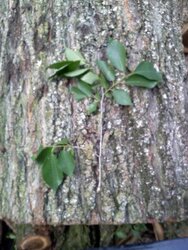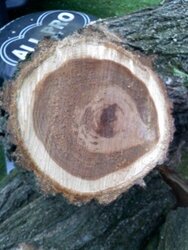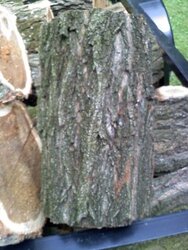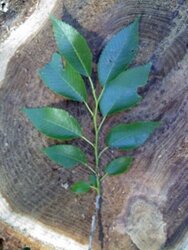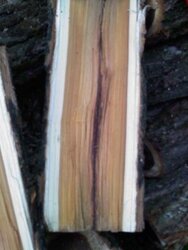Wood ID
- Thread starter Kneerat
- Start date
-
Active since 1995, Hearth.com is THE place on the internet for free information and advice about wood stoves, pellet stoves and other energy saving equipment.
We strive to provide opinions, articles, discussions and history related to Hearth Products and in a more general sense, energy issues.
We promote the EFFICIENT, RESPONSIBLE, CLEAN and SAFE use of all fuels, whether renewable or fossil.
You are using an out of date browser. It may not display this or other websites correctly.
You should upgrade or use an alternative browser.
You should upgrade or use an alternative browser.
- Status
- Not open for further replies.
indiana4spartans
Member
PA. Woodsman
Minister of Fire
I'm thinking Mulberry. I can see why you guys thought Walnut because of the Brown heartwood, but look at the 3rd picture (far right) and notice the yellowish heartwood. The bark doesn't jive with Walnut, but I could be wrong. Post some pictures of the grain when split-if it's brown then I'd say Walnut, if it's yellow I'd say Mulberry.
Jack Straw
Minister of Fire
bsearcey
New Member
PA. Woodsman
Minister of Fire
I've been looking at this on and off and really don't know for sure what it is; I originally said Mulberry, then I can see resembelance to Locust but the leaves aren't the same as mentioned. Are these pictures all from the same tree? The first picture has different bark than the others, but it could be a smaller (younger) part of the same tree. Post some split pics please!
ansehnlich1
Retired Hearth.com Member
We call it pignut hickory. It's a good burnin' wood. I had a pile of it last year. I see you're in PA too. My story and I'm stickin' to it...
PIGNUT HICKORY
PIGNUT HICKORY
bsearcey
New Member
Sorry. I honestly just looked at the bark in the third picture.
I'm going with Elm.
I've never split it, but everything I've read about elm says it's terrible to split. That one split you show looks pretty straight grained. I'm still saying Elm, but definitely not saying definitely again.
I'm going with Elm.
I've never split it, but everything I've read about elm says it's terrible to split. That one split you show looks pretty straight grained. I'm still saying Elm, but definitely not saying definitely again.
PA. Woodsman
Minister of Fire
Wood Duck
Minister of Fire
I think that is mulberry. The alternate, heart-shaped, toothed leaves are typical of the leaves on the tips of branches of some mulberry trees. Most White Mulberry (the common type in PA) have also some mitten-shaped leaves, and two-thumbed mitten-shaped leaves, but most have simple leaves like these as well. The bark looks like mulberry, and so does the yellowish wood. Although the leaves look reasonably good for elm, and so does the bark, the yellow wood seems more like mulberry. The leaves are definitely not locust or hickory - these are simple leaves, not compound.
dannynelson77
Feeling the Heat
Mulberry wood is yellow throughout though. This has a white outer ring to it. Because only the heartwood is yellow I would rule out Mulberry.
PA. Woodsman
Minister of Fire
Wood Duck said:I think that is mulberry. The alternate, heart-shaped, toothed leaves are typical of the leaves on the tips of branches of some mulberry trees. Most White Mulberry (the common type in PA) have also some mitten-shaped leaves, and two-thumbed mitten-shaped leaves, but most have simple leaves like these as well. The bark looks like mulberry, and so does the yellowish wood. Although the leaves look reasonably good for elm, and so does the bark, the yellow wood seems more like mulberry. The leaves are definitely not locust or hickory - these are simple leaves, not compound.
I originally thought Mulberry, especially from the first upper-left picture's bark and the yellow heartwood. But the bark on the lower picture doesn't quite jive with Mulberry to me, but I could be wrong...I'm waiting to hear from him what kind of aroma it has.
smokinj
Minister of Fire
leaves dont jive with mulberry! (nor is there fruit on it there full right now) thats locust or walnut!
RAY_PA
Feeling the Heat
pics 1&2 look more like walnut, pic 3 looks like locust, pic 4 looks like wlanut and pic 5 looks very much like locust. WALCUST, no doubt
Good one kneerat. The leaves don't jibe with the compound leaves of the walnut or locust. Maybe hackberry? It can have dark heartwood at times.
yes it sort of smells like cow manure when first split. Also after drying alittle the dark brown is turning light brown.
dannynelson77
Feeling the Heat
ansehnlich1
Retired Hearth.com Member
I am wrong, definitely not pignut hickory.
The leaves are alternate, not opposite.
I cut one of these trees down on a neighbors land and was astonished at the color of the wood when split, kind of an orange tint to it. If ya find out what it is let me know!
The leaves are alternate, not opposite.
I cut one of these trees down on a neighbors land and was astonished at the color of the wood when split, kind of an orange tint to it. If ya find out what it is let me know!
bsearcey
New Member
It is not walnut or hickory or locust if the leaves shown come from the same tree. All three of those have pinnately compound leaves.
http://www.dof.virginia.gov/trees/walnut-black.htm
http://www.dof.virginia.gov/trees/hickory-pignut.htm
http://www.dof.virginia.gov/trees/locust-black.htm
Hackberry does have a serrated leaf like that, but the bark is all wrong and the heartwood can be dark in hackberry, but not like this piece.
http://www.dof.virginia.gov/trees/hackberry.htm
Mulberry doesn't have a leaf like that and the bark is off.
http://www.dof.virginia.gov/trees/mulberry-red.htm
The leaf IMO is classic Elm with the one side of the base of the leaf margins being a little lower than the other side and the serrated edges. From the description on the DOF website the bark sounds right for both the slippery elm and the american elm. Check the underside of the leaf. Slippery elm should feel fuzzy.
http://www.dof.virginia.gov/trees/elm-amer.htm
http://www.dof.virginia.gov/trees/elm-slippery.htm
The only thing that doesn't fit for me is the way the PO said it split. Could just be lucky and got an elm with a straight grain.
http://www.dof.virginia.gov/trees/walnut-black.htm
http://www.dof.virginia.gov/trees/hickory-pignut.htm
http://www.dof.virginia.gov/trees/locust-black.htm
Hackberry does have a serrated leaf like that, but the bark is all wrong and the heartwood can be dark in hackberry, but not like this piece.
http://www.dof.virginia.gov/trees/hackberry.htm
Mulberry doesn't have a leaf like that and the bark is off.
http://www.dof.virginia.gov/trees/mulberry-red.htm
The leaf IMO is classic Elm with the one side of the base of the leaf margins being a little lower than the other side and the serrated edges. From the description on the DOF website the bark sounds right for both the slippery elm and the american elm. Check the underside of the leaf. Slippery elm should feel fuzzy.
http://www.dof.virginia.gov/trees/elm-amer.htm
http://www.dof.virginia.gov/trees/elm-slippery.htm
The only thing that doesn't fit for me is the way the PO said it split. Could just be lucky and got an elm with a straight grain.
ansehnlich1
Retired Hearth.com Member
bsearcey said:It is not walnut or hickory or locust if the leaves shown come from the same tree. All three of those have pinnately compound leaves.
http://www.dof.virginia.gov/trees/walnut-black.htm
http://www.dof.virginia.gov/trees/hickory-pignut.htm
http://www.dof.virginia.gov/trees/locust-black.htm
Hackberry does have a serrated leaf like that, but the bark is all wrong and the heartwood can be dark in hackberry, but not like this piece.
http://www.dof.virginia.gov/trees/hackberry.htm
Mulberry doesn't have a leaf like that and the bark is off.
http://www.dof.virginia.gov/trees/mulberry-red.htm
The leaf IMO is classic Elm with the one side of the base of the leaf margins being a little lower than the other side and the serrated edges. From the description on the DOF website the bark sounds right for both the slippery elm and the american elm. Check the underside of the leaf. Slippery elm should feel fuzzy.
http://www.dof.virginia.gov/trees/elm-amer.htm
http://www.dof.virginia.gov/trees/elm-slippery.htm
The only thing that doesn't fit for me is the way the PO said it split. Could just be lucky and got an elm with a straight grain.
This is a great analysis and it brings to the forefront a suspicion of mine.....maybe the pictured leaves did not come from the pictured tree. The wood and bark of the tree are almost undeniably pignut. In fact, I've done a second look at both leaf pictures in this thread and I'm thinking that the leaves in the first pic at the beginning of the thread look different than the second picture of leaves.....different shape, coloring, sheen, etc.
okotoks guy
New Member
- Status
- Not open for further replies.
Similar threads
- Replies
- 0
- Views
- 282


